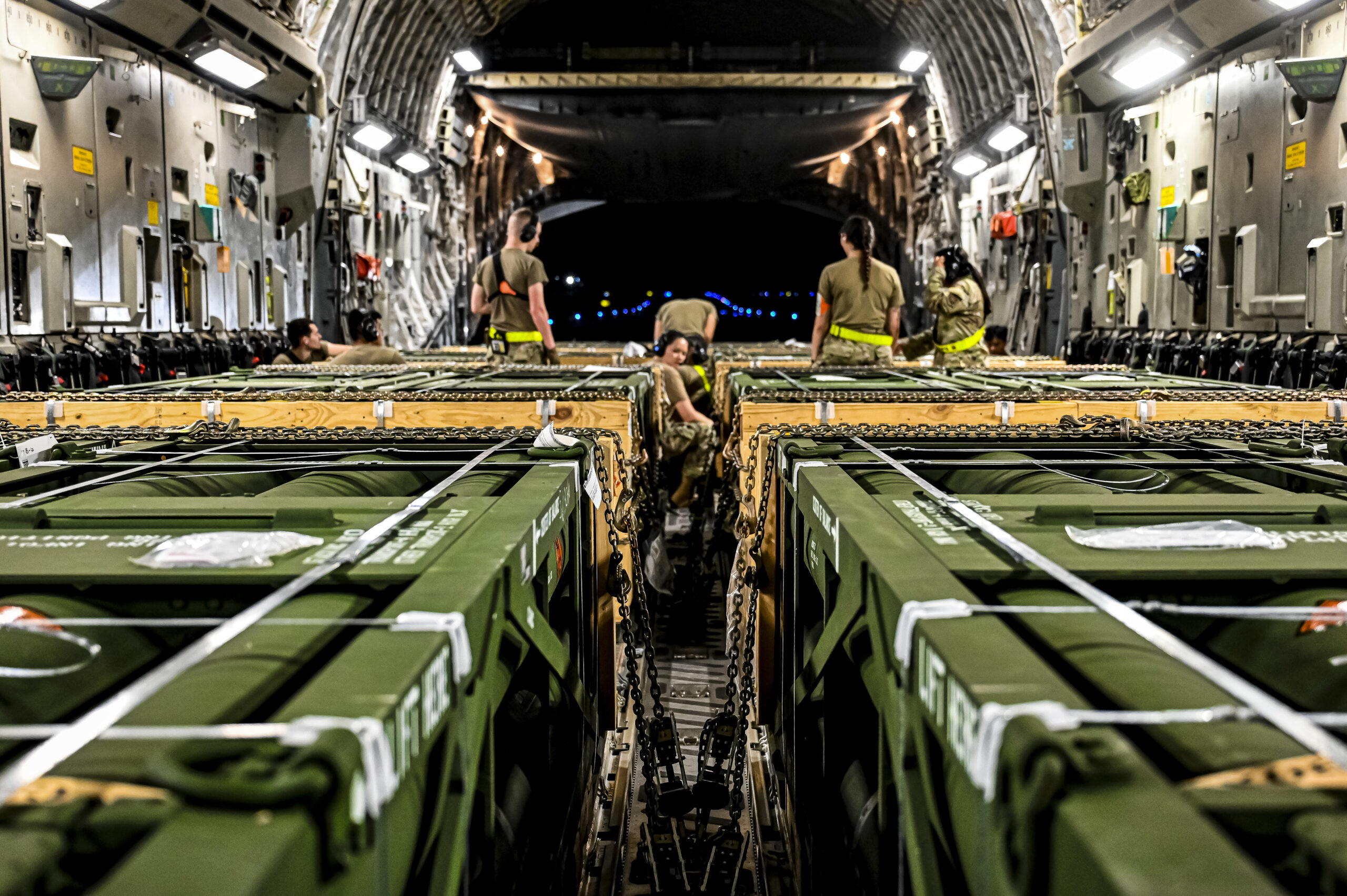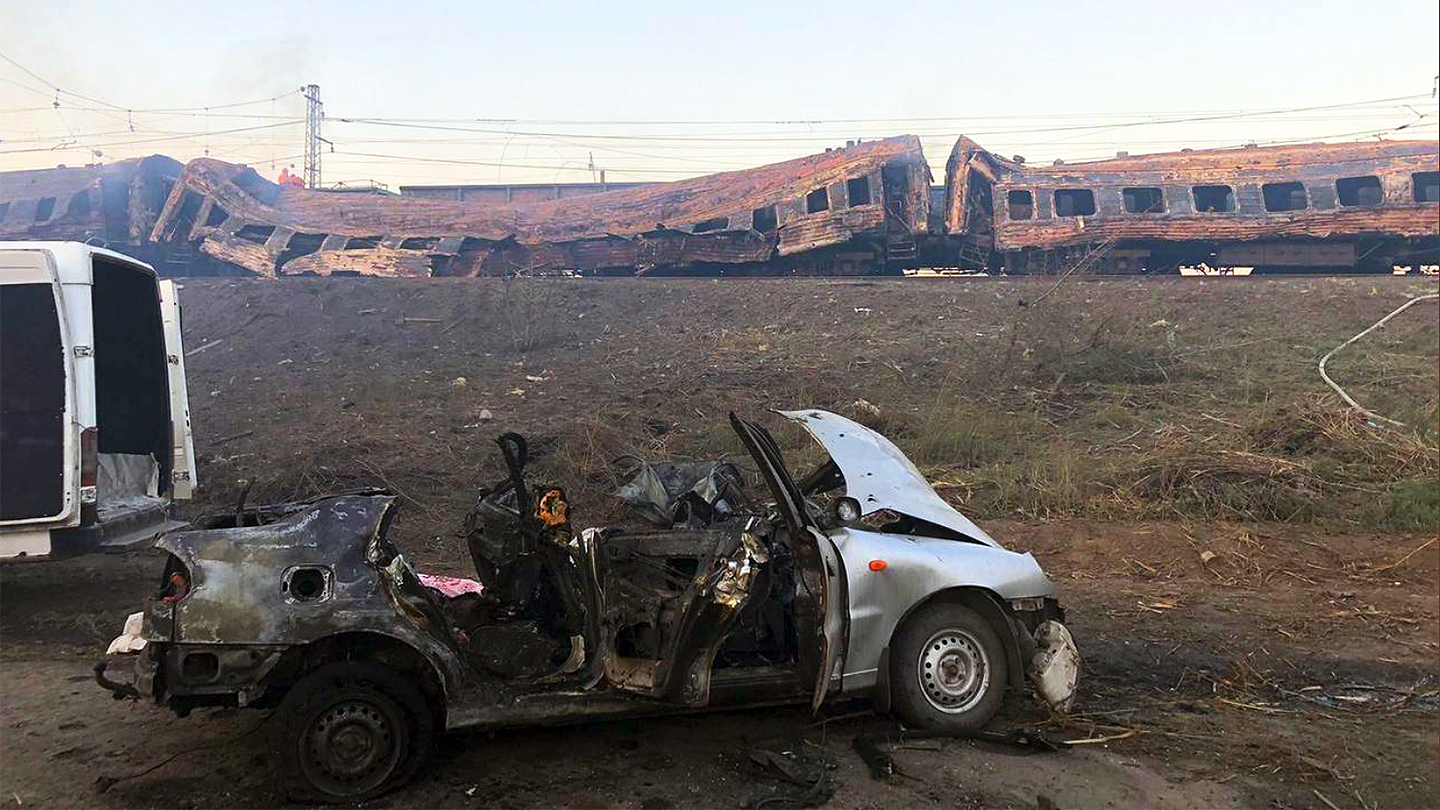Ukraine’s independence day, which fell six months to the day from Russia’s all-out, multi-front invasion of the country, dawned bright and clear in Kyiv, where residents were seen strolling through the city despite intermittent air raid sirens.
Russia was expected to make some show of force or launch attacks to divert attention from Ukraine’s defiant celebration of independence and at times the entire country, except Russian-occupied Crimea, was on alert for incoming airstrikes. Reports then began to mount that Ukrainian air defenses over Kyiv and other cities were intercepting incoming Russian missiles.
Later, the head of Ukraine’s Khmelnytskyi regional administration confirmed Russian missile strikes in that region.
The feared strikes continued throughout the rest of the day, seemingly aimed not at military targets but civilian infrastructure, which Russia has systematically targeted with cruise missiles and other weapons since February. The most gruesome strike of the day echoed earlier strikes on fleeing Ukrainian civilians at railway stations and other civilian infrastructure over the six-month-long conflict.
Late on Aug. 24, 15 people were confirmed killed and at least 50 injured when Russian missiles struck a civilian train station in Chaplyne, near Dnipro. Ukrainian President Zelensky confirmed the strike and the casualty count.
Photos of what appears to be the train show crumpled, burned-out passenger cars and other vehicles damaged along a roadway adjacent to the railway.
The death toll was later elevated to 22 killed, according to the Ukraine Ministry of Defense.
The U.S. State Department warned two days ago that Russia would likely target civilian infrastructure with strikes meant to divert or macabrely mark Ukrainian independence.
Ukraine was met also with an international message of support and pledges of new military assistance on the 31st anniversary of its independence. Several nations, including the U.S. and U.K., detailed sweeping new aid packages aimed at setting up the Ukrainian Armed Forces for a long-haul fight against invading Russian forces. You can read our complete coverage on the U.S. aid package, worth nearly $3B, the largest ever, in this report.
Before we get into the details, catch up on our previous rolling coverage here.
The Latest
The Washington Post published new details about the opening chapter of the war, including an anecdote supplied by Defense Minister of Ukraine Oleskii Reznikov in which he was asked by Belarusian counterpart Viktor Khrenin to sign an act of capitulation. Reznikov replied that he would gladly accept Russia’s capitulation.
The Ukraine Ministry of Defense is still offering the same deal six months later:
Some of the details are harrowing, with stories of a single Ukrainian brigade holding off a massed attack of Russian battle groups pressing toward the capital, Kyiv. Ukrainian troops reportedly fought to the death in some places, drawing comparisons to the Battle of Thermopylae where determined Spartans and their allies held off a Persian horde long enough for Greek city-states to rally and ultimately defeat the invaders.
Pushed back from the gates of Kyiv, the Russian military regrouped and launched its ongoing assault in the east and south, where the frontlines have remained almost unchanged since July.
Russia’s Donbas offensive is “making minimal progress and Russia anticipates a major Ukrainian counterattack” in the east, according to the Aug. 24 intelligence assessment of the war from the U.K. Ministry of Defense. “Operationally, Russia is suffering from shortages of munitions, vehicles, and personnel. Morale is poor in many parts of its military and its army is significantly degraded. Its diplomatic power has been diminished and its long-term economic outlook is bleak. Six months in and Russia’s war has proven both costly and strategically harmful.”
Just in time for Ukraine’s 31st birthday, and the start of the ongoing war’s seventh month, U.S. President Joe Biden announced on Aug. 24 the largest single security assistance package to date. The $2.98 billion tranche of weapons and other equipment includes air defense and artillery systems, ammunition, and anti-drone weapons, according to a statement from the White House.
This latest Ukraine Security Assistance Initiative package is designed to “ensure it can continue to defend itself over the long term,” though the White House did not initially disclose what specific systems were included.
“I know this independence day is bittersweet for many Ukrainians as thousands have been killed or wounded, millions have been displaced from their homes, and so many others have fallen victim to Russian atrocities and attacks,” Biden said in a prepared statement. “But six months of relentless attacks have only strengthened Ukrainians’ pride in themselves, in their country, and in their thirty-one years of independence. Today and every day, we stand with the Ukrainian people to proclaim that the darkness that drives autocracy is no match for the flame of liberty that lights the souls of free people everywhere.”
Ukrainian officials almost immediately began broadcasting their gratitude, with Minister of Defense Oleksii Reznikov quoting Patrick Henry’s famous revolutionary sentiment of liberty or death.
Once again, you can read our full coverage on the package here.
The U.S. military has posted images of security assistance being flown from Joint Base McGuire-Dix-Lakehurst, New Jersey, to Europe on their way to Ukraine. The 305th Aerial Port Squadron is shown loading the first Guided Multiple Launch Rocket System (GMLRS) pods that have been seen being shipped to Ukraine from the U.S.
Ukraine has fired GMLRS from U.S.-donated high mobility artillery rocket systems, or HIMARS, and NATO-gifted M270 tracked launchers to wallop Russian ammunition depots, supply lines, critical bridges, and other high-value targets in the past couple of months.

The potency of those weapons in Ukrainian service was demonstrated again on Aug. 24 with new strikes on the bridge over the Dnipro River at Nova Kakhovka.
Outgoing British Prime Minister Boris Johnson paid a surprise visit to Kyiv on Aug. 24, his third trip to the Ukrainian capital since the war began, where he met with president Volodymyr Zelensky. Johnson also posted a prerecorded video message to Twitter marking Ukraine Independence Day. “For however long it takes, the United Kingdom will stand with you,” Johnson said.
“For the past six months, the United Kingdom has stood shoulder-to-shoulder with Ukraine, supporting this sovereign country to defend itself from this barbaric and illegal invader,” Johnson said in a statement. “Today’s package of support will give the brave and resilient Ukrainian Armed Forces another boost in capability, allowing them to continue to push back Russian forces and fight for their freedom. What happens in Ukraine matters to us all, which is why I am here today to deliver the message that the United Kingdom is with you and will be with you for the days and months ahead, and you can and will win.”
Johnson also marked the occasion by announcing a new round of security assistance from his government.
The £54 million package includes 2,000 “state-of-the-art drones and loitering munitions” and 850 hand-launched Black Hornet micro-drones donated to Ukraine in partnership with Norway. The tiny drones, about the size of a banana, can be used for small unit recon missions, general scouting, and target identification. “Military personnel can be trained to fly the helicopter drones, which are smaller than a mobile phone, in under 20 minutes,” the U.K. government said in a statement. “Each drone feeds back live video and still images to allow forces on the ground to defend urban areas safely.”
You can read more about the Black Hornet and its capabilities in this previous War Zone piece.
For his enthusiastic support of Ukraine, Zelensky presented Johnson with a commemorative flagstone in Kyiv and awarded him the Order of Liberty medal.
New photos of an American-made high-speed anti-radiation missile, or HARM, have also surfaced. The tactical radar-seeking munition was identified from marked sections of remains from a strike. The missiles can be fired from Ukrainian MiG-29s to destroy Russian air defense systems.
Ukraine appears to have used one of its newly acquired AGM-88 HARMs to target a Russian Tor-M2 AD system. By detecting and locking onto electronic emissions generated by air defense radars, these missiles can effectively blind surface-to-air missile batteries by destroying the emitter outright, and sometimes the entire SAM system if it is an all-in-one road-mobile type.
While the Ukrainian Armed Forces have relied almost solely on Russian-built rotorcraft during the war, footage recently emerged online of a Eurocopter (now Airbus) EC225 Super Puma twin-engine medium-lift helicopter flying in the east.
Two more crowdfunded Bayraktar TB2 drones have arrived in Ukraine. Following a successful fundraising campaign by NATO supporters, the Turkish-made unmanned aerial systems were donated free of charge by manufacturer Baykar. These UAS are stamped with the slogan “The People’s Bayraktar.”
Another configuration of armed dune buggy is now zipping around the battlefield in Ukraine, likely hunting Russian tanks with a French-donated Milan 2 anti-tank guided missile (ATGM) on top. Dune buggies of various types, carrying an array of armaments are fielded by Ukrainian troops to perform quick hit-and-run missions against Russian armored vehicles. You can read all about this here.
Even in areas they occupy, Russian forces and their collaborators are not safe from Ukrainian insurgents and operatives. On Wednesday morning, Ivan Shusko, head of the occupation authorities in Mykhailivka, located in Zaporizhzhia Oblast, was assassinated with a bomb planted under his car. Security camera footage of the blast circulated online showing the car rolling to a stop with smoke billowing from the driver’s door and under the hood. It also shows the destroyed car in the aftermath of the bombing. These types of assassinations are becoming more common in Russian-occupied areas of Ukraine.
While high-end weaponry and artillery shells get the most attention, just some fresh reliable trucks to get around in can be a huge help to Ukrainian forces. Businessmen from a supermarket chain provided 90 pickups to Ukrainian forces.
Turkey continues to side with Ukraine as it attempts to balance its questionable relationship with Moscow:
We will continue to update this post until we state otherwise.
Contact the author: Dan@thewarzone.com
